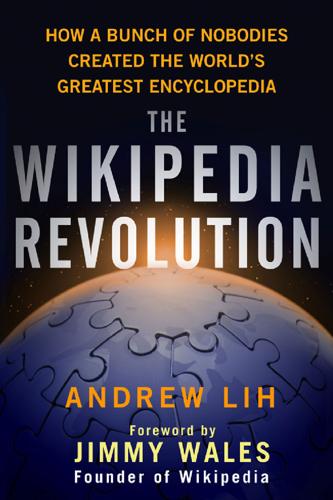
The Wikipedia Revolution: How a Bunch of Nobodies Created the World's Greatest Encyclopedia
by
Andrew Lih
Published 5 Jul 2010
“Know It All: Can Wikipedia Conquer Expertise?” The New Yorker, July 31, 2006, http://www.newyorker.com/archive/2006/07/31/060731fa_fact. Chapter 3. WIKI ORIGINS 14. C2 Wiki, http://c2.com/cgi/wiki?WikiWikiHyperCard. 15. Wikimania 2005, keynote speech, Ward Cunningham. 16. C2 Wiki, http://c2.com/cgi/wiki?WikiWikiHyperCard. 17. Gillies, James & Robert Cailliau. How the Web Was Born: The Story of the World Wide Web. (Oxford: Oxford University Press, 2000), p. 214. 232_Notes 18. C2 Wiki, http://c2.com/doc/etymology.html. 19. http://sunir.org/sunir/. Chapter 4. WIKI INTRODUCED 20. Larry Sanger, “Let’s make a wiki” (email), Nupedia-L mailing list, Nupedia, January 10, 2001, http://web.archive .org/web/20030414014355/http://www.nupedia.com/ pipermail/nupedia-l/ 2001-January/000676.html (retrieved on May 1, 2008). 21. http://en.wikipedia.org/wiki/User_talk:Mark_Richards/Archive_2#The_ .22Encyclo pedia_that_Slashdot_Built.22_Awards. 22.
…
For the tech-savvy folks who first experienced Ward’s wiki, it was rather familiar—it closely mirrored the conventions used for keywords in computer programming. In time, CamelCase would become quite commonplace even in the commercial world. YouTube, MySpace, LiveJournal, and other arbitrary mixes of upper- and lowercase have become part of the dot-com lexicon. On March 25, 1995, Cunningham launched his WikiWikiWeb creation on c2 .com, and invited folks to visit. More importantly, he asked people to edit and contribute to the site what they knew about programming and software engineering. They would not need an account or password, which was quite odd even for computer veterans. There would be no gatekeeper, no central editor to submit to.
…
People weren’t afraid of trying to edit the wiki, because nothing was ever permanently lost or destroyed. Pages could be resurrected and reverted back to their original state. Finally, after eight years of waiting, he had an easy to edit, networked, collaborative resource that people could share in creating. Cunningham’s WikiWikiWeb (more affectionately known as Ward’s Wiki at http://c2.com/cgi/wiki) became a curiosity and a central location for programmers interested in patterns in computer code. He would later dub it the Portland Pattern Repository, as it allowed people to individually contribute to it. WikiWikiWeb became popular not just for the computer programming knowledge that accumulated, but also because of the wiki community that arose from it.

Clean Agile: Back to Basics
by
Robert C. Martin
Published 13 Oct 2019
Craig Larman and Vic Basili wrote a history that is summarized on Ward Cunningham’s wiki,2 and also in Larman’s book, Agile & Iterative Development: A Manager’s Guide.3 But Agile was not the only game in town. Indeed, there was a competing methodology that had enjoyed considerable success in manufacturing and industry at large: Scientific Management. 2. Ward’s wiki, c2.com, is the original wiki—the first ever to have appeared in the internet. Long may it be served. 3. Larman, C. 2004. Agile & Iterative Development: A Manager’s Guide. Boston, MA: Addison-Wesley. Scientific Management is a top-down, command-and-control approach. Managers use scientific techniques to ascertain the best procedures for accomplishing a goal and then direct all subordinates to follow their plan to the letter.
…
Then Came Continuous Build In 2001, ThoughtWorks changed the game significantly. They created CruiseControl,7 the first continuous build tool. I remember Mike Two8 giving a late-night lecture about this at a 2001 XP Immersion. There’s no recording of that speech, but the story went something like this: 7. https://en.wikipedia.org/wiki/CruiseControl 8. http://wiki.c2.com/?MikeTwo CruiseControl allows the checkin time to shrink down to a few minutes. Even the most minor change is quickly integrated into the mainline. CruiseControl watches the source code control system and kicks off a build every time any change is checked in. As part of the build, CruiseControl runs the majority of the automated tests for the system and then sends email to everyone on the team with the results.
…
No cold houses nor dark thoughts. No complaints about Jean and Joan and who knows who. Everybody gets 30 seconds or so to answer those three questions. Then the meeting is over and everyone returns to work. Done. Finito. Capisce? Perhaps the best description of the standup meeting is on Ward’s wiki: http://wiki.c2.com/?StandUpMeeting. Pigs and Chickens? I won’t repeat the ham-and-eggs story here. You can look it up in the footnote10 if you are interested. The gist is that only developers should speak at the standup. Managers and other folks may listen in but should not interject. 10. https://en.wikipedia.org/wiki/The_Chicken_and_the_Pig From my point of view, I don’t care who speaks so long as everyone follows the same three-question format and the meeting is kept to about 10 minutes.

Dreaming in Code: Two Dozen Programmers, Three Years, 4,732 Bugs, and One Quest for Transcendent Software
by
Scott Rosenberg
Published 2 Jan 2006
“The typical behavior of a student”: Gerald Weinberg, The Psychology of Computer Programming, Silver Anniversary Edition (Dorset House, 1998), p. 50. “I figured, OK, I’m running this repository”: Ward Cunningham’s talk at the OOPSLA Conference, October 2004, Vancouver, B.C. The Portland Pattern Repository is at http://c2.com/ppr/. The OSAF wiki is at http://wiki.osafoundation.org. Brooks’s discussion of the Tower of Babel is in The Mythical Man-Month Anniversary Edition (Addison Wesley, 1995), p. 74. “There are a couple of dark sides”: James Gosling, “Sharpen the Axe: The Dark Side,” blog entry from January 4, 2005, at http://today.java.net/jag/page13.htm#106.
…
“programmers are like carpenters”: Brian Hayes, “The Post-OOP Paradigm,” American Scientist, March–April 2003, at http://www.americanscientist.org/template/Asset Detail/assetid/17307. “These have the advantages”: From Kent Beck and Ward Cunningham, “A Laboratory for Teaching Object-Oriented Thinking,” from the OOPSLA ’89 Conference Proceedings, October 1989, New Orleans, at http://c2.com/doc/oopsla89/paper.htm. Barry Boehm, “A Spiral Model of Software Development and Enhancement,” in ACM SIGSOFT Software Engineering Notes, August 1986. “Part of the purpose of the workshop”: Brian Marick’s blog posting from March 17, 2004, is at http://www.testing.com/cgi-bin/blog/2004/03/17# march17.
…
The Agile Manifesto is at http://agilemanifesto.org/. “We were taking all these practices”: Ron Jeffries’s quote is from Sam Williams, “Totally Awesome Software?” in Salon, May 29, 2002, at http://archive.salon.com/tech/feature/2002/05/29/ extreme_programming/index.htm. “Always implement things”: The YAGNI principle is defined at http://xp.c2.com/YouArentGonnaNeedIt.htm. “Deliver Crap Quickly”: From Robert Lefkowitz’s blog posting titled “Extreme Programming Refactored” from April 2004; it used to be at http://r0ml.blogs.com/fot/2004/04/extreme_program .htm and is now offline. Available at http://web.archive.org/web/20040810155153/http:// r0ml.blogs.com/fot/2004/04/extreme_program.htm.

Sass for Web Designers
by
Dan Cederholm
Published 14 May 2013
The important thing is to take advantage of one of these tools to make your life a little easier (http://bkaprt.com/sass/34/). REFERENCES Shortened URLs are numbered sequentially; the related long URLs are listed below for reference. Chapter 1 1: http://pragprog.com/the-pragmatic-programmer 2: http://c2.com/cgi/wiki?DontRepeatYourself 3: http://www.w3.org/People/Bos/DesignGuide/maintainability.html 4: http://sass-lang.com/about.html Chapter 2 5: http://rubyinstaller.org 6: http://mhs.github.com/scout-app/ 7: http://incident57.com/codekit 8: http://livereload.com 9: http://compass.handlino.com Chapter 3 10: http://blog.engineyard.com/2011/front-end-maintainability-with-sass-and-style-guides 11: http://www.w3.org/TR/css-variables/ 12: http://compass-style.org 13: http://bourbon.io/ Chapter 4 14: https://github.com/scottjehl/picturefill Resources 15: http://sass-lang.com/docs/yardoc/file.SASS_REFERENCE.html 16: http://thesassway.com 17: http://css-tricks.com/search-results/?

Writing Effective Use Cases
by
Alistair Cockburn
Published 30 Sep 2000
They tighten and refine the design from there. 1.http://members.aol.com/humansandt/papers/oonewcomers.htm 2.Read the original article: Beck, K., Cunningham, W., "A laboratory for object-oriented thinking", ACM SIGPLAN 24(10):1-7, 1989, or the book: Wirfs-Brock, R., Wilkerson, B., Wiener, L., Designing Object-Oriented Software, Prentice-Hall, 1990. Online, visit http:// c2.com/cgi/wiki?CrcCards or http://members.aol.com/humansandt/papers/crc.htm. 173 Chapter 17. Use Cases in the Overall Process Use Cases to UI Design - Page 174 17.4 Use Cases to UI Design Larry Constantine and Lucy Lockwood, in Software for Use, and Luke Hohmann, in GUIs with Glue, have written better than I can about designing the user interface.
…
Cockburn, A., "VW-Staging", http://members.aol.com/acockburn/papers/vwstage.htm Cockburn, A., "An Open Letter to Newcomers to OO", http://members.aol.com/humansandt/ papers/oonewcomers.htm Cockburn, A., "CRC Cards", http://members.aol.com/humansandt/papers/crc.htm Cunningham, W., CrcCards", http://c2.com/cgi/wiki?CrcCards McBreen, P., "Test cases from use cases", http://www.cadvision.com/roshi/papers.html Online resources useful to your quest. The web has huge amounts of information. Here are a few starting points. http://www.usecases.org http://members.aol.com/acockburn http://www.foruse.com http://www.pols.co.uk/usecasezone/ 246 F Flexography 44, 46, 48, 50, 52, 54, 56, 58, 60 247
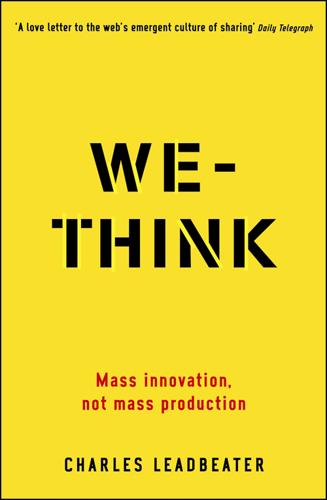
We-Think: Mass Innovation, Not Mass Production
by
Charles Leadbeater
Published 9 Dec 2010
Available from http://www.cjr.org/ issues/2003/5/blog-jensen.asp 6 http://portal.eatonweb.com 7 http://www.technorati.com/about 8 http://slashdot.org and http://www.digg.com http://www.plastic.com http://www.fark.com 9 See Anna Maybank, ‘Web 2.0’, at www.charlesleadbeater. net. 10 See http://english.ohmynews.com 11 Nicole Ellison, Charles Steinfield and Cliff Lampe, ‘Spatially Bound Online Social Networks and Social Capital: The Role of Facebook’, Department of Telecommunication Information Studies and Media, Michigan State University, 2006. Available from http:// msu.edu/%7enellison/facebook_ica_2006.pdf 12 Danah Boyd, ‘None of This Is Real: Identity and Participation in Friendster’, University of California, Berkeley. Available from http://www.danah.org/ papers/NoneOfThisIsReal.pdf 13 http://c2.com/cgi/wiki?WikiHistory 14 The Economist New Media Survey, ‘The Wiki Principle’, The Economist, April 2006. Available from http://www.economist.com/surveys/displaystory. cfm?story_id=6794228 15 See Steven Levy and Brad Stone, ‘The New Wisdom of the Web’, Newsweek, April 2006. Available from http:// www.msnbc.msn.com/id/12015774/site/newsweek 16 Fred Turner, From Counterculture to Cyberculture (Chicago, IL/London: University of Chicago Press, 2006) 17 Patrice Flichy, The Internet Imaginaire (Cambridge, MA: MIT Press, 2007) 18 Charles Leadbeater, ‘The DIY State’, Prospect 130, January 2007 19 Fred Turner, op. cit. 20 John Markoff, What the Dormouse Said: How the Sixties Counterculture Shaped the Personal Computer Industry (Penguin, 2006) 21 Patrice Flichy, The Internet Imaginaire (Cambridge, MA: MIT Press, 2007) 22 Jonathan Lethem, ‘The Ecstasy of Influence’, Harper’s Magazine, February 2007 23 Garrett Hardin, ‘The Tragedy of the Commons’, Science 162 (1968), pp. 1243–48 24 Elenor Ostrom, Governing the Commons (Cambridge University Press, 1990) 25 Lawrence Lessig, Code and Other Laws of Cyberspace (New York, NY: Basic Books, 1999) and Free Culture (New York, NY: Penguin Press, 2004) 26 Melvyn Bragg, The Routes of English (BBC Factual and Learning, 2000); Melvyn Bragg, The Adventure of English (Hodder & Stoughton Ltd, 2003) 27 Jonathan Lethem, ‘The Ecstasy of Influence’, Harper’s Magazine, February 2007 28 Cory Doctorow et al., ‘On “Digital Maoism: The Hazards of the New Online Collectivism” By Jaron Lanier’, Edge (2006). http://www.edge.org/discourse/digital_ maoism.html 29 Paul A.
…
, Creative Review, August 2006 Wright, Robert, Nonzero (Abacus, 2001) Zeldin, Theodore, Conversation (Harvill Press, 1998) Zittrain, Jonathan L., ‘The Generative Internet’, Harvard Law Review 119. 1974 (2006) Zuboff, Shoshana, and James Maxim, The Support Economy: Why Corporations Are Failing Individuals and the Next Episode of Capitalism (Allen Lane, 2002) Web addresses www.blizzard.com/inblizz/profile.shtml www.bookcrossing.com c2.com/cgi/wiki?WikiHistory counter.li.org/ english.ohmynews.com/ www.fark.com www.ige.com www.plastic.com portal.eatonweb.com www.slashdot.org www.technorati.com/about www.worldofwarcraft.com INDEX 42 Entertainment 10, 11 A ABC 173 academia, academics 6, 27, 48, 59 Acquisti, Alessandro 210 Adam, James 95 adaptation 109, 110, 121 advertising 104, 105, 129, 173, 180, 219 Aegwynn US Alliance server 99 Afghanistan 237 Africa broadband connections 189 mobile phones 185, 207 science 196 use of Wikipedia 18 Aids 193, 206, 237 al-Qaeda 237 Alka-Seltzer 105 Allen, Paul 46 Altair BASIC 46 Amadeu, Sérgio 202 amateurism 105 Amazon 86 America Speaks 184 American Chemical Society 159 anarchy cultural 5 Wikipedia 16 Anderson, Chris: The Long Tail 216 Apache program 68 Apple 42, 103, 104, 135, 182 iPhone 134 iPods 46 Arendt, Hannah 174, 176 Argentina 203 Arrayo, Gloria 186 Arseblog 29, 30 Arsenal Football Club 29, 30 Arsenal.com 29 arXiv 160 Asia access to the web 5, 190 attitude to open-source 203 and democracy 189 mobile phones 166, 185 and open-source design communities 166–7 Ask a Ninja 57, 219 assembly line 93, 130 assets 224 astronomy 155, 162–3 authority 110, 115, 233 authorship and folk culture 57, 58 and mapping of the human genome 62 Azerbaijan 190 B bacteria, custom-made 164 Baker, Steve 148 Banco do Brazil 201 Bangladesh 205–6 banking 115, 205–6 Barber, Benjamin: Strong Democracy 174 Barbie, Klaus 17 Barbie dolls 17 Barefoot College 205 barefoot thinking 205–6 Barthes, Roland 45 Batchelor, Charles 95 Bath University 137 BBC 4, 17, 127, 142 news website 15 beach, public 49, 50, 51 Beach, The (think-tank) xi Bebo 34, 85, 86 Bedell, Geraldine x, xii–xiii Beekeepers 11, 15 Benkler, Yochai 174 The Wealth of Networks 194 Berger, Jorn 33 Bermuda principles 160 Billimoria, Jeroo 206 BioBrick Foundation 164 biology 163 open-source 165 synthetic 164–5 BioMedCentral 159 biotechnology 154, 163–4, 196–7, 199 black fever (visceral leishmaniasis) 200 Blackburn Rovers Football Club 29 Blades, Joan 188 Blizzard Entertainment 100 Bloc 8406 191 Blogger.com 33 blogs, blogging 1, 3, 20, 29–35, 57, 59, 74, 75, 78, 86, 115, 159, 170, 171, 176, 179, 181–2, 183, 191, 192, 214, 219, 229 BMW 140 Bohr, Neils 93 bookshops 2 Boulton, Matthew 54–5 Bowyer, Adrian 139, 140, 232 Boyd, Danah 213, 214 Bradley, Bill 180 Brand, Stewart 39–40, 43, 63 brands 104, 109 Brazil 201–2 Brenner, Sydney 62–5, 70, 77, 118, 231 Brief History of Time, A (Hawking) 163 Brindley, Lynne 141, 142, 144–5 British Library, London 141, 142, 144, 145 British Medical Journal 159 British National Party 169 Brooks, Fred 77–8 Brooks Hall, San Francisco 38 BT 112 bugs, software 70, 72, 165 bulletin boards 34, 40, 68, 77 Burma 190, 191 Bush, President George W. 18, 33–4, 180, 183 business services 130, 132, 166 C C. elegans (Caenorhabditis elegans) 62–5 Cambia 197 Cambridge University Press 159 camcorders 11 Campbell, Anne 176 Cancer Genome Atlas 160 capital 224 capitalism 224 commune 121, 125 managerial 24 modern 91, 121 social dimension of 90 Carlson, Rob 164 Carnegie Mellon University 210 cars manufacture 135–6 sharing 153 CBS 173 Center for Bits and Atoms, MIT 139 CERN (European Organization for Nuclear Research) 30–31, 159 Chan, Timothy 106, 107 chat rooms 165 Chavez, President Hugo 203 Cheney, Dick 180 Chevrolet 105 Chicago: Full Circle council project 184 China based on privileged access to information 236 creative and cultural sectors 129–30 hackers 234 Internet connection 190, 204 makes available genetic data 199 motor-cycle production 136–7 online games market 106 open-access scientific data 159–60 open-source designs 141 politics 171, 192 power struggle in 235 spending on R & D 96, 159 web censorship 190–91 Chinese Communist Party 171, 235 Chongquing, China 136 Cisco 190 Citibank 207 Citizendium 14 climate change 170, 239 Clinton, Bill 174, 188 Clinton, Senator Hillary 181, 182, 183 CNN 15 co-operatives 121, 122, 123, 188 co-ordination 109, 110–11 coffee houses, London 95 Coke 109–10, 239 Cold War 169, 235 Coles, Polly xiii collaboration 9, 22, 31, 32, 36, 67, 79–80, 81, 82 collaborative innovation 65, 70, 75 and commerce 227 computer game 99, 100 Cornish tin-mining 55 and healthcare 150 and the library of the future 145 new technologies for 227–8 open 126, 128 peer 239 public services 145, 146, 152, 153 scientific 154, 155–6 We-Think 21, 23, 24, 146 Collis, Charles 134 Columbia University 212 commerce 25, 38, 48, 52, 57, 98, 227 commons 49, 50, 51–3, 79, 80, 124, 191, 226 communes 39–40, 46, 90, 121, 122, 128 communication(s) 130, 168, 174, 206, 239 mobile 186 Communism, collapse of 6 communities collaborative 117 and commerce 48 and commons 52 conversational 63 Cornish tin-mining 55 creative 70, 95 diverse 79–80 egalitarian 27, 48, 59, 63, 64 hacker 232 healthcare 151, 152 independence of 23 of innovation 54 libertarian, voluntaristic 45 Linux 65, 227 and loss of market for local newspapers 3 meritocratic 63 open-source 45, 68, 75, 80, 83, 95–6, 102, 109, 110, 111 open-source design 166–7 of scientists 53, 228 self-governing 59, 79, 80, 97, 104, 232 sharing and developing ideas 25 web 21, 23 worm-genome researchers 62–5 community councils 77, 80, 82 Community Memory project 42–3 companies computer-games 128 employee-owned 121, 122 shareholder-owned 122, 123, 125 see also corporations; organisations computer games 60, 127, 218 children and 147 created by groups on the web 7, 23, 87 modularity 78 multi-player 7, 204 success of World of Warcraft 98–9 tools for creating content 74 and We-Think 23 computer-aided design 134 computers democratising how information is accessed 139 distrust of 39 Goa School Computers Project 200–201 laptop 5, 36, 82, 155 mini- 135 personal 39, 46, 203 punch-cards 38 and science 154, 155 viruses 3, 4 connect 67, 75–9 Connectiva 201 consumer spending 131 consumers 98–108 consumer innovators 101–3 consumption constraints 25–6 engaging 89 fans 103–4 freedom 218 and innovation risk 100–101 participant 98–108 urban 124 contribute 67, 70, 71, 72, 73, 74–5 conversation 53, 54, 63, 69, 77, 93, 95, 113, 118, 174 Copernicus, Nicolaus 162 copyright 124, 157, 196 core 66, 67, 68–9, 70 Cornell University 233 ‘Cornish’ engines 55–6, 136, 229 Cornish tin-mining industry 54–6, 63, 125, 136 corporations centralisation of power 110 closed 128 and collaborative approaches to work 109 the cost of corporate efficiency 89–90 difficulty in making money from the web 7 hierarchies 88, 110 industrial-era 88 leadership 115, 117–19 loss of stability 122 restructuring and downsizing 88–9 see also companies; organisations counter-culture (1960s) 6, 27, 39, 45, 46, 59 Counts, David 183 Craigslist 3, 40, 118, 128, 218 Creative Commons 124 creative sector 129–30 creativity 1–2, 3, 5, 6, 9, 67, 82–3 collaborative 7, 20, 58, 86, 154 collective 39, 57–8 consumers 89 corporate 91–2 emergence of 93, 96 enabled by the web 1–2, 3, 5, 19, 26, 218–21, 222, 227 freedom to create 218–21 and interaction 119 and open innovation 93 origin of 112–13 social 5, 7, 58, 59, 82, 83, 86 tools for 218, 219 Crick, Francis 52, 62, 76 crime 153, 169, 183 criminality 1, 3 crowds 23, 61, 70, 72, 77 Crowdspirit 134 cultural élite 2 cultural sector 129–30 culture academic 38 anti-industrial 27, 28 basis of 4 collaborative 135 consumerist 172 corrosion of 4 cultural anarchy 5 folk 6, 27, 56–9, 220, 226 hippie 38 individual participation 6 political 171 popular 102 post-industrial 27, 28 pre-industrial 27, 28 We-Think 28, 59, 62, 169, 194, 230, 232–3, 238 Web 2.0 45 web-inflected 27 Western 239 wiki 14 work 114 YouTube cultural revolution 3 Cunningham, Ward 35–6 cyber cafés 107, 190, 192, 201, 204 Cyworld 34, 85, 86 D Dali, Salvador 105 Darby, Newman 102 Darpa 164 David, Paul 53 de Soto, Hernando 224–5 The Mystery of Capital 224 de Vellis, Phil 182 Dean, Howard 176–7, 178, 180, 185 Dean Corps 177 Debian 66 Debord, Guy 45, 46 decentralisation 7, 13, 39, 46, 59, 78, 226, 232 decision-making 78, 82, 84, 115, 173, 174 del.i.cious 86 democracy 1, 3, 5, 6, 7, 16, 24, 170–74, 175, 176–92 basis of 174 conversational democracy at a national level 184 ‘craftsmen of democracy’ 174 Dean campaign 178 democratic advances 184 depends on public sovereignty 172 formal 195 geek 65 Homebrew 176 public debate 170, 171 and We-Think 170, 221, 239 Department for International Development (DFID) 207 Descartes, René 19–20 design 166 modular 136–7 open-source 133–5, 140, 141, 162–3, 166–7 developing world Fab Labs in 166 government attitudes to the Internet 190 impact of the web on 166 mobile phones 185–6 and open-access publishing 166 and open-source design communities 166–7 and open-source software 200–203 research and development 196 and We-Think’s style of organisation 204 diabetes 150 Digg 33 discussion forums 77 diversity 9, 23, 72, 76, 77, 79–80, 112, 121 division of labour 111 DNA description of the double helix (Watson and Crick) 52, 62, 76 DNA-sequencing 164–5 Dobson, John 102, 162–3 Doritos 105 dot.com boom 106 Dupral 68 Dyson (household-goods company) 134 Dyson, Freeman 163, 164 E E-Lagda.com 186 Eaton, Brigitte 33 Eatonweb 33 eBay 40, 44, 102, 128, 152, 165, 216–18, 221, 229, 235 Ebola virus 165 Eccles, Nigel xi economies of scale 137 economy digital 124, 131, 216 gift 91, 226 global 192 global knowledge 239 of ideas 6 individual participation 6 industrial 122 market 91, 221 a mass innovation economy 7 networked 227 of things 6 UK 129, 130 and We-Think 129 Edison, Thomas 72, 93, 95 EditMe 36 education 130, 146–50, 167, 183, 194, 239 among the poorest people in the world 2, 193 civic 174 a more convivial system 44 Edwards, John 181 efficiency 109, 110 Einstein, Albert: theory of relativity 52 elderly, care of 170 Electronic Arts 105, 106, 128, 177 Electronic Frontier Foundation 40 electronics 93, 135 Eli Lilly (drugs company) 77 Ellis, Mark: The Coffee House: a social history 95 enclosures 124 Encyclopaedia Britannica, The 15–18, 126 encyclopaedias 1, 4, 7, 12–19, 21, 23, 36, 53, 60, 61, 79, 161, 231 Encyclopedia of Life (EOL) 161, 226 Endy, Drew 164, 165 energy 166, 232, 238 Engelbart, Doug 38–9, 59 engineering 133, 166 Environmental Protection Agency 152 epic poems 58, 60 equality 2, 24, 192–7, 198, 199–208 eScholarship repository, University of California 160 Estonia 184, 234 Estrada, President Joseph 186 ETA (Basque terrorist group) 187 European Union (EU) 130 Evans, Lilly x Evolt 68, 108 F Fab Labs 139, 166, 232 fabricators 139 Facebook 2, 34–5, 53, 142, 152, 191, 193, 210 factories 7, 8, 24 families, and education 147 Fanton, Jonathan 161 Fark 33 Feinstein, Diane 176 Felsenstein, Lee 42, 43, 44 fertilisers 123 Field Museum of Natural History, Harvard University 161 file-sharing 51, 58, 135, 144, 233 film 2, 3, 4, 47, 86, 129, 216, 218, 220–21 film industry 56 filters, collaborative 36, 86 financial services 130, 132 Financial Times 118 First International Computer (FIC), Inc. 136, 141 flash mobbing 10, 11 Flickr 34, 85, 86, 210, 218–19 Food and Drug Administration (US) 92 Ford, Henry 24, 93, 96 Fortune 500 company list 122 Frank, Ze (Hosea Jan Frank) 57, 219 freedom 1, 2, 6, 24, 208, 209, 210–21, 226 French, Gordon 41, 42 friendly societies 188 Friends Reunited 34 friendship 5, 233 combinatorial 95 Friendster 34, 35 fundamentalists 232 G Gaia Online 35 Galileo Galilei 154 gambling 169 GarageBand software 57, 135, 148 Gates, Bill 46, 47, 51, 227 Gates Foundation 160 geeks 27, 29–36, 37, 38, 48, 59, 65, 179 gene-sequencing machines, automated 64 genetic engineering 164, 196–7, 235 Georgia: ’colour revolution’ 187 Gershenfeld, Neil 139–40, 166, 232 GetFrank 108 Ghana, Fab Lab in 139 Gil, Gilberto 202 Gjertsen, Lasse 56, 218 Gland Pharma 200 global warming 238 globalisation 202, 228, 239 Gloriad 155 GM 135 Goa School Computers Project 200–201 Goffman, Erving 103–4 Goldcorp Inc. 132–3, 153 Golden Toad 40 GoLoco scheme 153 Google x, 1, 29, 32, 33, 47, 66, 97, 104, 113–14, 128, 141, 142, 144, 212 Google Earth 161 Gore, Al 64 governments in developing countries 190 difficulty in controlling the web 7 GPS systems 11 Grameen Bank 205–6, 208 ‘grey’ sciences 163 grid computing 155 Gross, Ralph 210 group-think 23, 210–11 groups 230–31 of clever people with the same outlook and skills 72 decision-making 78 diverse 72, 80, 231 and tools 76–7 Guthrie, Woody 58 H Habermas, Jurgen 174 hackers 48, 74, 104, 140, 232, 234 Hale, Victoria 199 Halo 2 science fiction computer game 8 Hamilton, Alexander 17–18 Hampton, Keith 183–4 Hanson, Matt xi health 130, 132, 146, 150–52, 167, 183, 239 Heisenberg, Werner 93 Henry, Thierry 29 Hewlett Packard 47 hierarchies 88, 110, 115 hippies 27, 48, 59, 61 HIV 193 Homebrew Computer Club 42, 46–7, 51, 227 Homebrew Mobile Phone Club 136 Homer Iliad 58 Odyssey 58 Homer-Dixon, Thomas: The Upside of Down 238–9 Hubble, Edwin 162 Human Genome Project 62, 64, 78, 155, 160, 161, 226 human rights 206 Hurricane Katrina 184 Hyde, Lewis: The Gift 226 hypertext 35, 39 I I Love Bees game 8, 10–12, 15–16, 19, 20, 69, 231 IBM 47, 66, 97 System/360 computer 77 idea-sharing 37, 94, 237, 239 as the biggest change the web will bring about 6 with colleagues 27 and consumer innovators 103 dual character of 226 gamers 106 Laboratory of Molecular Biology 63 through websites and bulletin boards 68 tools 222 We-Think-style approach to 97 and the web’s underlying culture 7 ideas combining 77 and creative thinking 87 from creative conversations 93, 95 gifts of 226 growth of 222, 239 and the new breed of leaders 117–18 ratifying 84 separating good from bad 84, 86 testing 74 the web’s growing domination 1 identity sense of 229 thieves 213–14 Illich, Ivan 43–5, 48 Deschooling Society 43, 44, 150 Disabling Professions 43 The Limits to Medicine 43, 152 Tools for Conviviality 44 independence 9, 72, 231 India Barefoot College 205 creative and cultural sectors 129–30 Fab Lab in 139 Internet connection 190, 204 mobile phones 207 and One World Health 200 spending on R & D 96 telephone service for street children 206 individuality 210, 211, 215, 216, 233 industrialisation 48, 150, 188 information barriers falling fast 2 computers democratise how it is accessed 139 effect of We-Think 129 large quantities on the web 31–2 libraries 141, 142, 143, 145 looking for 8 privileged access to 236 sharing 94, 136 the web’s growing domination 1 Wikipedia 19 Innocentive 77 innovation 5, 6, 91–3, 94, 95–8, 109 among the poorest people in the world 2 biological 194 collaborative 65, 70, 75, 90, 119, 146, 195 collective 170, 238 and competition/co-operation mix 137 Cornish mine engines 54–6 corporate 89, 109, 110 and creative conversations 93, 95 creative interaction with customers 113 cumulative 125, 238 decentralised 78 and distributed testing 74 and diverse thinking 79 and education 147 independent but interconnected 78 and interaction 119 and Linux 66 local 139 a mass innovation economy 7 medical 194 open 93, 96–7, 125, 195 in open-source communities 95–6 and patents 124 pipeline model 92, 93, 97 R & D 92, 96 risks of 100–101 social 170, 238 successful 69 user-driven 101 and We-Think 89, 93, 95, 125, 126 the web 2, 5, 7, 225 Institute for One World Health 199–200 Institute for Politics, Democracy & the Internet (IPDI) 179 Institute of Fiscal Studies 131 institutions convivial 44 industrial-era 234 and knowledge 103 and professionals 3, 5 public 142, 145 Instructables site 134 Intel 97 intellectual property 75, 122, 124, 125, 234 law 124–5 intelligence, collective bloggers 33 getting the mix right 23 Google’s search system 32 I Love Bees and Wikipedia examples 8, 10–19 milked by Google 47 the need to collaborate 32 self-organisation of 8 and social-networking sites 35 the web’s potential 3, 5 International Polar Year (IPY) 156, 226 Internet broadband connection 178, 189, 192 combined with personal computers (mid-1990s) 39 cyber cafés 107, 190, 192, 201, 204 Dean campaign 177 in developing countries 190 draws young people into politics 179, 180 an early demonstration (1968) 38 and Linux 66 news source 178–9 open-source software 68 openness 233 and political funding 180 pro-am astronomers 163 used by groups with a grievance 168 in Vietnam 189–90, 191 investment 119, 121, 133, 135 Iran 190, 191 Iraq war 18, 134, 191 Israel 18 Ito, Joi 99 J Japan politics 171 technology 171 JBoss 68 Jefferson, Richard 197, 199 Jodrell Bank Observatory, Macclesfield, Cheshire 162 JotSpot 36 journalism 3, 74, 115, 170–71 Junker, Margrethe 206 K Kampala, Uganda 206 Kazaa music file-sharing system 144 Keen, Andrew 208 The Cult of the Amateur 208 Kelly, Kevin 211 Kennedy, John F. 176 Kenya 207 Kepler, Johannes 162 Kerry, John 180 Khun, Thomas 69 knowledge access to 194, 196 agricultural 194 barriers falling fast 2 collaborative approach to 14, 69 encyclopaedia 79 expanding 94 gifts of 226 individual donation of 25 and institutions 103 and networking 193 and pro-ams 103 professional, authoritative sources of 222 sharing 27, 44, 63, 70, 199 spread by the web 2, 3 Wikipedia 16, 18, 19, 195 Korean War 203 Kotecki, James (’EmergencyCheese’) 182 Kraus, Joe 36 Kravitz, Ben 13 Kuresi, John 95 Kyrgyzstan: ’colour revolution’ 187 L Laboratory of Molecular Biology, Cambridge 62–3, 77 labour movement 188 language 52–3 Lanier, Jaron 16, 210–11, 213 laptop computers 5, 36, 82, 155 lateral thinking 113 leadership 89, 115, 116, 117–19 Lean, Joel 55 Lean’s Engine Reporter 55, 63, 77 Lee, Tim Berners 30–31 Lego: Mindstorms products 97, 104, 140 Lewandowska, Marysia 220, 221 libraries 2, 141–2, 143, 144–5, 227 life-insurance industry (US) 123 limited liability 121 Linked.In 35 Linux 65–6, 68, 70, 74, 80, 85, 86, 97, 98, 126, 127, 128, 136, 201, 203, 227 Lipson Community College, Plymouth 148 literacy 194 media 236 Lloyd, Edward 95 SMS messaging (texting)"/>London coffee houses 95 terrorist bombings (July 2005) 17 Lott, Trent 181–2 Lula da Silva, President Luiz Inacio 201 M M-PESA 207, 208 MacArthur Foundation 161 McCain, John 180 MacDonald’s 239 McGonigal, Jane 11, 69 McHenry, Robert 17 McKewan, Rob 132–3, 153 McLuhan, Marshall: Understanding the Media 45 Madrid bombings (March 2004) 186–7 Make magazine 165 management authoritative style of 117 and creative conversation 118 hierarchies 110 manufacturing 130, 132, 133–7, 138, 139–41, 166, 232 niche 139 Marcuse, Herbert 43 Marin 101 Mark, Paul xi market research 101 market(s) 77, 90, 93, 102, 123, 216, 226–7 Marsburg virus 165 Marx, Karl 224 mass production 7, 8, 24, 56, 96, 227, 232, 238 Massachusetts Institute of Technology (MIT) 139, 164, 233 Matsushita 135 media 129, 130, 156, 172, 173, 182, 211 literacy 236 Meetup 179, 185 Menlo Park laboratory, New Jersey 95 Merholz, Peter 33 meritocracy 16, 63 Microsoft 46, 47, 51, 56, 75, 109–10, 126, 127, 144, 202, 203, 204, 239 Office 201 Windows 200 Windows XP 66 Middle East 170, 189, 190, 192 Milovich, Dimitry 102 ‘minihompy’ (mini homepage) 204 Minnesota Mining and Materials 121 mobile phones 5 in Africa 185, 207 in Asia 166, 185 camera phones 74, 115, 210 children and 147 in developing-world markets 207–8 with digital cameras 36 flash mobs 10 I Love Bees 11 in India 207 open-source 136, 203 politics 185–9 SMS messaging (texting) 101–2, 185, 187, 214, 215 mobs 23, 61 flash 10, 11 modularity 77, 84 Moore, Fred 41–2, 43, 46, 47, 59, 227 More, Thomas: Utopia 208 Morris, Dick 174 Morris, Robert Tappan 233 Mosaic 33 motivation 109–12, 148 Mount Wilson Observatory, California 162 mountain bikes 101 MoveOn 188–9 Mowbray, Miranda xi music 1, 3, 4, 47, 51, 52, 57, 102, 135, 144, 218, 219, 221 publishing 130 social networking test 212–13 mutual societies 90, 121 MySpace 34, 44, 57, 85, 86, 152, 187, 193, 214, 219 MySQL 68 N National Football League (US) 105 National Health Service (NHS) 150, 151 National Public Radio (NPR) 188 Natural History Museum, London 161 Nature magazine 17 NBC 173 neo-Nazis 168 Netflix 216, 218 Netherlands 238 networking by geeks 27 post-industrial networks 27 social 2–7, 20, 23, 34–5, 36, 53, 57, 86, 95, 147, 149, 153, 159, 171, 183–4, 187, 193, 208, 210, 212, 213–15, 230, 233 New Economy 40 New Orleans 184 New York Magazine 214 New York Review of Books 164 New York Stock Exchange 95 New York Times 15, 182, 191 New Yorker magazine 149 Newmark, Craig 118 news services 60, 61, 171, 173, 178–9 newspapers 2, 3, 30, 32, 34, 171, 172, 173 Newton, Sir Isaac 25, 154 niche markets 216 Nixon, Richard 176 NLS (Online System) 39 Nokia 97, 104, 119, 140 non-profits 123 Nooteboom, Bart 74 Noronha, Alwyn 200–201 Norris, Pippa 189 North Africa, and democracy 189 Nosamo 35, 186 Noyes, Dorothy 58 Nupedia 13, 14 Nussbaum, Emily 214–15 O Obama, Barack 181, 191 Ofcom (Office of Communications) 31 OhmyNews 34, 87, 204, 231 oil companies 115 Oldenburg, Henry 25, 53–4, 156 Ollila, Jorma 119 Online System (NLS) 39 Open Architecture Network (OAN) 133–4 Open Net Initiative 190 Open Office programme 201 Open Prosthetics 134 Open Source Foundation 97 OpenMoko project 136 OpenWiki 36 O’Reilly, Tim 31 organisation commons as a system of organisation 51 pre-industrial ideas of 27, 48 social 20, 64, 165 We-Think’s organisational recipe 21 collaboration 21, 23 participation 21, 23 recognition 21 Organisation for Economic Co-operation and Development (OECD) 196 organisations civic 189 open/collaborative vs. closed/hierarchical models 89, 126, 127, 128 public 152 successful 228 see also companies; corporations Orwell, George: 1984 182 Ostrom, Elinor 51–2, 80 ownership 6, 119, 120, 121–6, 127, 128, 225 Oxford University 234 P paedophiles 3, 168, 213–14 Page, Scott xi, 72 Pakistan 237 Palace of Fine Arts, San Francisco 40 parallel universes 7 participation 23, 216, 223, 230, 232 consumers 98, 100 public services 145, 146, 150, 152, 153 a We-Think ingredient 21, 24 Partido Populaire (PP) (Spain) 187 patents 55, 56, 92, 97, 102, 124, 154, 196, 197, 199 Paul, Ron 185 Pawson, Dave x–xi Pax, Salam 57 peasants 27, 48, 59 peer recognition 54, 106, 111, 156, 228–9 peer review 53, 54, 156, 165, 236 peer-to-peer activity 53–4, 135, 148, 151 People’s Computer Company 41 People’s Democratic Party (Vietnam) 191 performance art/artists 2, 10 performance management 110 Perl 68 Peruvian Congress 202 Pew Internet & American Life 31, 179 pharmaceutical industry 92–3, 195–6, 197, 199, 200 Phelps, Edmund 114–15, 220 Philippines: mobile phones 185–6 Philips, Weston 105 photographs, sharing of 34, 75, 86, 218–19 Pitas.com 33 Plastic 33 Playahead 35 podcasts 142 Poland 220–21 polar research 156 politics bloggers able to act as public watchdog 181–2, 183 decline in political engagement 171–2 democratic 173 donations 179 funding 180–81 and journalism 170–71 and mobile phones 185–9 online 183 the online political class 179 and online social networks 35, 86 political advocates of the web 173–4 racist groups on the web 169 and television 173, 183 ultra-local 183, 184 US presidential elections 173, 179 videos 182 the web enters mainstream politics 176 young people drawn into politics by the Internet 179 Popper, Karl 155 Popular Science magazine 102 pornography 169, 214 Post-it notes 121 Potter, Seb 108–9 Powell, Debbie ix power and networking 193 technological 236 of the We-Think culture 230 of the web 24–5, 185, 233 PowerPoint presentations 140, 142, 219 privacy 210, 211 private property 224, 225 Procter and Gamble (P & G) 96–7, 98 productivity 112, 119, 121, 151, 227, 232 agricultural 124 professionals, and institutions 3, 5 property rights 224 public administration 130 Public Broadcasting Service 188 Public Intellectual Property Research for Agriculture initiative 199 Public Library of Science 159 public services 132, 141–2, 143, 144–53, 183 public spending 146 publishing 130, 166 science 156–7, 159–60 Putnam, Robert 173, 184 Python 68 Q quantum mechanics 93 ‘quick-web’ 35 R racism 169, 181–2 radio 173, 176 RapRep (Rapid Replicator) machines 137, 138, 139, 140, 141, 232 Rawls, John: A Theory of Justice 194 Raymond, Eric 64 recognition 21, 223 peer 54, 106, 111, 156 record industry 56, 102 recycling 111 Red Hat 66, 227 Red Lake, Ontario 132, 133 research 166 market 101 pharmaceutical 195–6 research and development (R & D) 92, 96, 119, 196 scientific 154–7, 159–65 retailing 130, 132 Rio Grande do Sul, Brazil 201 Roh Moo-hyun, President of South Korea 35, 186 Roosevelt, Franklin 176 Roy, Bunker 205 Royal Botanic Gardens, Kew, Surrey 161 Royal Society 54 Philosophical Transactions 25, 156 Ryze.com 34 S Sacca, Chris 113, 114 Safaricom 207 St Louis world fair (1904) 75–6 Samsung xi, 203 Sanger, Larry 13, 14, 16 Sanger Centre, Cambridge 155 Sao Paolo, Brazil 201 SARS virus 165 Sass, Larry 139 satellite phones 11 Saudi Arabia 190 scanners 11 Schumacher, E.

Designing Social Interfaces
by
Christian Crumlish
and
Erin Malone
Published 30 Sep 2009
Why The wiki approach has unleashed a torrent of creativity on the Web and seems to have captured in its principles the fundamental grain of digital, electronic, web-enabled collaboration. Related patterns “Learn from Games” on page 36 “Ongoing Sharing” on page 239 Chapter 17 As seen on WikiWikiWeb (http://c2.com/cgi/wiki) Crowdsourcing What Some jobs are too big for the immediate group of engaged collaborators to manage on its own. The community will benefit if the interface provides a way to break a large project into smaller pieces and engage and give incentives to a wider group of people (or “crowd”) to tackle those smaller pieces (Figure 12-15).
…
As seen on Amazon Mechanical Turk (http://www.mturk.com/mturk/welcome) Assignment Zero (http://zero.newassignment.net/) The ESP Game (http://www.cs.cmu.edu/~biglou/ESP.pdf) iStockphoto (http://istockphoto.com) ReCAPTCHA (http://recaptcha.net/) SETI@home (http://setiathome.ssl.berkeley.edu/) Threadless (http://threadless.com) Download at WoweBook.Com 330 Chapter 12: Barnraising Further Reading “Berners-Lee on the read/write web,” BBC News, August 9, 2005, http://news.bbc.co.uk/2/ hi/technology/4132752.stm Cross Cultural Collaboration, http://crossculturalcollaboration.pbwiki.com/ “Deriving Process-driven Collaborative Editing Pattern from Collaborative Learning Flow Patterns,” by Olivera Marjanovic, Hala Skaf-Molli, Pascal Molli, and Claude Godart, http://www.ifets.info/journals/10_1/12.pdf “Edit This Page,” by Dave Winer, http://www.scripting.com/davenet/1999/05/24/editThisPage.html Edit This Page PHP, http://sourceforge.net/projects/editthispagephp/ Paylancers blog, http://paylancers.blogspot.com/ The Power of Many, http://thepowerofmany.com Regulating Prominence: A Design Pattern for Co-Located Collaboration (http://www.ida.liu.se/~matar/coop04arvola-web.pdf) “The Rise of Crowdsourcing,” by Jeff Howe, Wired 14.06, http://www.wired.com/wired/archive/14.06/crowds.html “The Simplest Thing That Could Possibly Work,” by Bill Venners, http://www.artima.com/intv/simplest.html Universal Edit Button, http://universaleditbutton.org/Universal_Edit_Button Wiki Design Principles, http://c2.com/cgi/wiki?WikiDesignPrinciples “The Wiki Way,” by Jon Udell, http://weblog.infoworld.com/udell/2004/10/19.html Wired Crowdsourcing blog, http://crowdsourcing.typepad.com/ Download at WoweBook.Com Chapter 13 Social Media Junkies Unite! Some commons-based peer production efforts are less self-conscious on the part of the users, and emerge more as a function of distributed coordinate behavior, like del.icio.us or Flickr.

The Innovators: How a Group of Inventors, Hackers, Geniuses and Geeks Created the Digital Revolution
by
Walter Isaacson
Published 6 Oct 2014
Andrew Lih, The Wikipedia Revolution (Hyperion, 2009), 1111. See also Ward Cunningham and Bo Leuf, The Wiki Way: Quick Collaboration on the Web (Addison-Wesley, 2001); Ward Cunningham, “HyperCard Stacks,” http://c2.com/~ward/HyperCard/; Ward Cunningham, keynote speech, Wikimania, Aug. 1, 2005. 81. Ward Cunningham, “Invitation to the Pattern List,” May 1, 1995, http://c2.com/cgi/wiki?InvitationToThePatternsList. 82. Ward Cunningham, correspondence on the etymology of wiki, http://c2.com/doc/etymology.html. 83. Tim Berners-Lee interview, Riptide Project, Schornstein Center, Harvard, 2013. 84. Kelly Kazek, “Wikipedia Founder, Huntsville Native Jimmy Wales, Finds Fame Really Cool,” News Courier (Athens, AL), Aug. 12, 2006. 85.
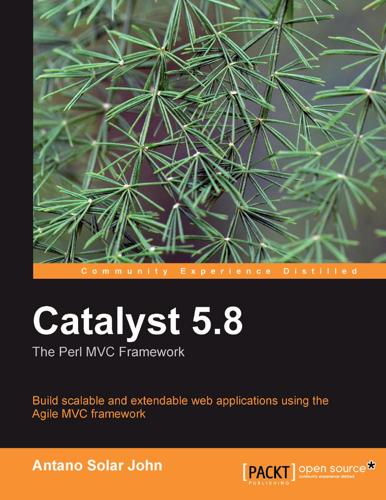
Catalyst 5.8: The Perl MVC Framework
by
Antano Solar John
,
Jonathan Rockway
and
Solar John Antano
Published 15 Nov 2010
Files=1, Tests=2, 0 wallclock secs ( 0.07 cusr + 0.01 csys = 0.08 CPU) You can take this technique a step further and write test cases in a separate (non-Perl) file and load that file as the %tests hash. Then, you can have someone other than a programmer to write your test cases. If you choose to follow this route, then you should take a look at FIT (http://fit.c2.com/), and the Test::FITesque module on CPAN. Testing a database ChatStat is a pretty database-heavy application, so there's no way to avoid testing the database part. We can make testing the database less painful by providing an easy way for creating an empty database just for testing. This is easy to do with SQLite; we just create a temporary database, deploy our schema to it, run the tests, and then delete the database.
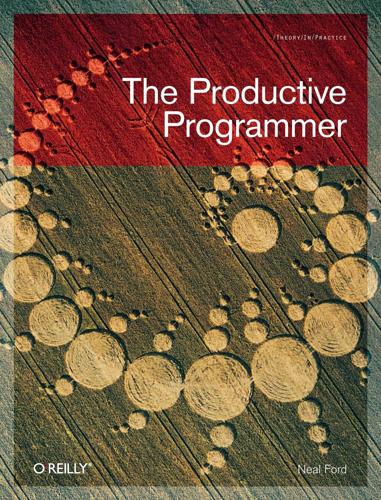
The Productive Programmer
by
Neal Ford
Published 8 Dec 2008
Some hard-fought knowledge about software development is not intuitive. The idea that you can design the entire software up front, and then just transcribe it seems logical, but it doesn’t work in the real world of constant change. Fortunately, a giant catalog of nonintuitive software lore exists in the Anti Patterns catalog (http://c2.com/cgi/wiki? AntiPatternsCatalog). This is the ancient lore of software. Rather than gnashing your teeth in frustration when your boss is forcing you to use a library of subquality code, point out to him that he’s falling into the “Standing on the Shoulder of Midgets” anti pattern, and he’ll see that you aren’t the only one who thinks it’s a bad idea.
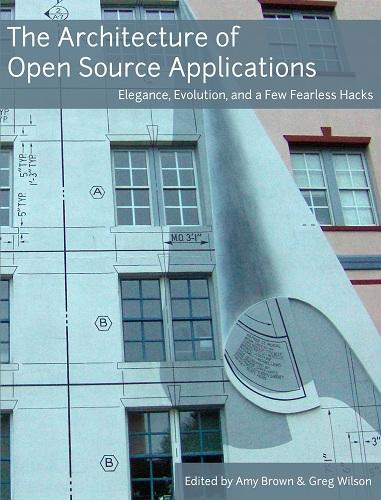
The Architecture of Open Source Applications
by
Amy Brown
and
Greg Wilson
Published 24 May 2011
Whether those automation hooks are going to be based on WebDriver is an open question, but we can hope! The next few years are going to be very interesting. As we're an open source project, you'd be welcome to join us for the journey at http://selenium.googlecode.com/. Footnotes http://fit.c2.com This is very similar to FIT, and James Shore, one of that project's coordinators, helps explain some of the drawbacks at http://jamesshore.com/Blog/The-Problems-With-Acceptance-Testing.html. For example, the remote server returns a base64-encoded screen grab with every exception as a debugging aid but the Firefox driver doesn't.
…
Footnotes https://github.com/audreyt/wikiwyg-js http://one.laptop.org/ http://seeta.in/wiki/index.php?title=Collaboration_in_SocialCalc http://search.cpan.org/dist/Web-Hippie/ http://about.digg.com/blog/duistream-and-mxhr https://github.com/gimite/web-socket-js http://perlcabal.org/syn/S02.html http://fit.c2.com/ http://search.cpan.org/dist/Test-WWW-Mechanize/ http://search.cpan.org/dist/Test-WWW-Selenium/ https://www.socialtext.net/open/?cpal http://opensource.org/ http://www.fsf.org https://github.com/facebook/platform https://github.com/reddit/reddit The Architecture of Open Source Applications Amy Brown and Greg Wilson (eds.)
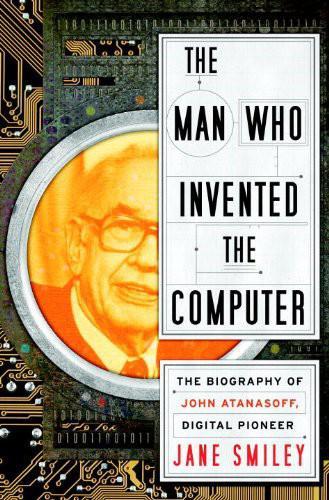
The Man Who Invented the Computer
by
Jane Smiley
Published 18 Oct 2010
_Presper_Eckert. 11 “Even as I was putting it together”: Zuse, p. 71. 12 “So, of course, when after weeks or months”: Ibid., p. 76. 13 “hardly anyone could imagine”: Ibid., p. 77. 14 “If Aiken and my father had had revolvers”: Welch, http://ed-thelen.org/comp-hist/TheCompMusRep/TCMR-V12.html. 15 “Despite the fact”: Copeland et al., p. 2. 16 “Colossus was a special-purpose machine”: Flowers, “Colossus,” p. 96. 17 “When I came to put them together”: Roberts, p. 469. 18 “Hitler had sent Field Marshall Rommel”: Flowers, “D-Day at Bletchley Park,” p. 80. 19 “The result was a defeat”: Ibid. 20 “even up to 26 June”: Roberts, p. 470. 21 “If I had … spent the war interned”: Flowers, “D-Day at Bletchley Park,” p. 82. 22 “It is regretted that it is not possible”: Good and Timms, http://www.ellsbury.com/tunny/tunny-000.htm. 23 “You’d be working on a problem”: I. J. Maskell, http://c2.com/cgi-bin/wiki?TommyFlowers. 24 “Flowers received very little remuneration”: Ibid. Chapter Seven 1 “More steerage-class Jewish families”: Macrae, p. 42. 2 “he was one grade below me”: Marton, p. 41. 3 “Before he finished high school”: Macrae, p. 71. 4 “He joined in class pranks”: Ibid., p. 41. 5 “From all over the globe”: Marton, p. 64. 6 “by his first question”: Macrae, p. 281. 7 “an internal summary of their work”: McCartney, p. 118. 8 “Johnny grabbed other people’s ideas”: Macrae, p. ix. 9 “The primary memory would be fairly small”: Ibid., p. 309. 10 “Dr.
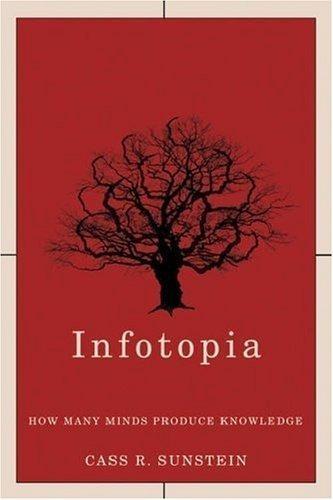
Infotopia: How Many Minds Produce Knowledge
by
Cass R. Sunstein
Published 23 Aug 2006
For an overview, see “FAQ: People, Julian Simon’s Bet with Paul Ehrlich,” Overpopulation.com, at http:// www.overpopulation.com/faq/People/julian_simon.html (last visited Jan. 28, 2005). Chapter 5 / 1. See Bol Leuf and Ward Cunningham, The Wiki Way: Quick Collaboration on the Web (Boston: Addison-Wesley, 2001), 15. 2. For those interested in the original WikiWikiWeb site, the place to go is http:/c2.com/cgi/wiki; it includes many thousands of pages with discussions of software design. 3. Ibid. 4. Ibid., 17. 5. All quotations from the Wikipedia site are available via http:// en.wikipedia.org/wiki/Main_Page. 252 / Notes to Pages 140–50 6. http://en.wikipedia.org/wiki/Wikipedia:Replies_to_common_ objections. 7.
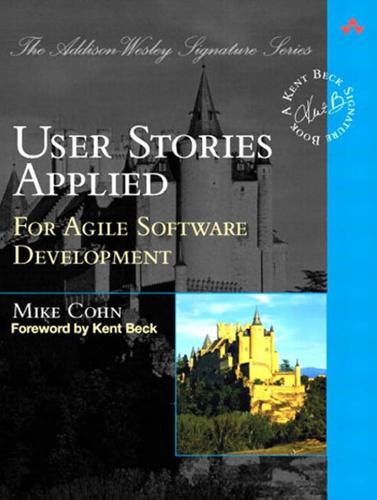
User Stories Applied: For Agile Software Development
by
Mike Cohn
Published 1 Mar 2004
J., 148 Twelve XP practices, 234–240 U Unified Process, 8, 137 Untestable stories, 27 Usability testing, 72 Use case briefs, 140 User, distinction between purchaser and, 20–21 User interface guidelines, 80 User interface testing, 72 User interface (UI): details, including too soon, 159–160 writing two, 183 User Interviews, 45–47 open-ended and contextfree questions, 46–47 User proxies, 55–66 customer responsibilities, 65 customers, 59–60 developer responsibilities, 65 development manager, 57 domain experts, 58–59 former users, 59 marketing group, 59 salespersons, 57–58 trainers and technical support personnel, 61 users’ manager, 55–56 what to do when working with, 61–63 User role cards, 33–36, 192 positioning, 193 sample, 37 User role modeling, 9, 31–41 consolidating roles, 35–36 customer responsibilities, 41 developer responsibilities, 40 extreme characters, 39 initial set of user roles: brainstorming, 33–34 organizing, 34–35 on-site users, 39–40 personas, 38–39 refining roles, 36–37 role attributes, 36 South Coast Nautical Supplies (example project), 195–197 steps in, 33–37 user roles, 31–33 User roles: attributes, 36–37 brainstorming an initial set of, 33–34 consolidating, 35–36 identifying, 33 identifying roles that represent a single user, 34 including in user stories, 80–81 initial set of: brainstorming, 33–34 organizing, 34–35 refining, 36–37 role attribute, 36–37 South Coast Nautical Supplies (example project), 191–198 User stories: advantages over alternative approaches, 13–14 aspects of, 4 augmenting in requirements documentation style, 6 comprehensibility of, 148 customer responsibilities, 155 and the daily Scrum meeting, 174 and deferring detail, 150 defined, 4–5 descriptions, 4 developer responsibilities, 155 estimating, 87–95 approach, 88–90 customer responsibilities, 95 developer responsibilities, 94 pair programming, 92–93 story points, 87–88, 91–92 as a team, 88 triangulating an estimate, 90–91 IEEE 830 compared to, 133–136 and iterative development, 149–150 and participatory design, 152 prioritizing, 98–101 and the product backlog, 173 relationship between bug reports and, 185 representing functionality valued by users, 5 retaining, 184–185 scenarios compared to, 141–142 size for planning, 148–149 size of, 6 splitting, 6, 12 in the sprint planning meeting, 173–174 in the sprint review meeting, 174 support for opportunistic development, 151–152 tacit knowledge, build up of, 153 and technical jargon, 14 test descriptions, 7–8 with too much detail, 19 use cases compared to, 137–141 and the user interface (UI), 26, 79–80, 139–140, 159–160, 181–183 and verbal communication, 145–148 User task forces, 62, 65 Users’ manager, 64 Users stories, initial collection of, 209–210 V Value to purchasers/users, 20–22 Velocity, 9–10, 15, 91–92, 113 actual, 119–120 calculations, 119 guessing at, 104–105 initial, 104–105 iteration burndown charts, 121–123 measuring, 117–119 measuring/monitoring: customer responsibilities, 127 developer responsibilities, 127 planned, 119–120 Verbal communication, 145–148 VersionOne, 179 W Wake, Bill, 17, 76, 233 Waterfall-oriented process, 8 “White book” (Beck), 234 Wideband Delphi approach, 88 Wikis, 179 Williams, Laurie, 237 Won’t-have features, release plan, 98–99 Writing stories, 17–29 combined stories, 18 combining stories, 26–27 customer responsibilities, 28 developer responsibilities, 28 estimatable stories, 22–23 highly dependent stories, 17–18 independent stories, 17–18 negotiable stories, 18–19 small stories, 23–27 splitting stories, 18 story size, 23–27 testable stories, 27 X XP, See Extreme Programming (XP) XPlanner, 179 Footnotes Chapter 3 [1] Much of the discussion of user roles in this chapter is based on the work of Larry Constantine and Lucy Lockwood. Further information on user role modeling is available at their website at www.foruse.com or in Software for Use (1999). Chapter 6 [1] The Framework for Integrated Test, FIT, is available at fit.c2.com. [2] FitNesse is availabe from fitnesse.org. [3] For information on credit card validity, see www.beachnet.com/~hstiles/cardtype.html. Chapter 8 [1] Joshua Kerievsky on extremeprogramming@yahoogroups.com, August 5, 2003. Chapter 9 [1] For information on DSDM see DSDM: Business Focused Development (Stapleton 2003).
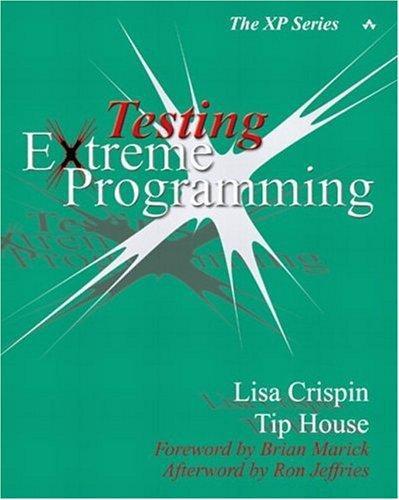
Testing Extreme Programming
by
Lisa Crispin
and
Tip House
Published 15 Apr 2003
Wiki Whiteboards aren't practical for every documentation need. A project wiki, which is a Web site everyone can easily update on the fly, is a good resource for keeping everybody in sync. (Wiki-wiki is an alliterative substitute for quick, and we use wiki as a shorthand for the official name, WikiWikiWeb. See www.c2.com/cgi/wiki?WikiHistory for a history of wiki.) If your team doesn't have one and you can see beneficial applications of using one, suggest it. Here are some of the pages that might be on the project wiki: Customer contact information Iteration planning output: task tracking Status Standup notes Grade cards Customers' schedules, when and where they'll be offsite and onsite Technical resources; how-tos, intranet access account info Install information and access to installation files Metrics Acceptance tests UML diagrams Metrics XP is designed to be lightweight and streamlined, producing fewer expensive artifacts.

Exploring Python
by
Timothy Budd
Published 17 Feb 2009
A community of readers for the wikipedia periodically examine recently altered articles to weed out inappropriate content, but such deletions are rare in comparison to the vast amount of useful information. The wiki web we develop in this chapter is much simpler, and closer in spirit to the original wiki web (http://c2.com/cgi/wiki). The basic idea of the wiki is that information is organized using topic words, termed pattern words. A pattern word is written as a single word with embedded capital letters, for example PatternWord. (This convention grew up in the context of the study of ideas termed design patterns, hence the name.
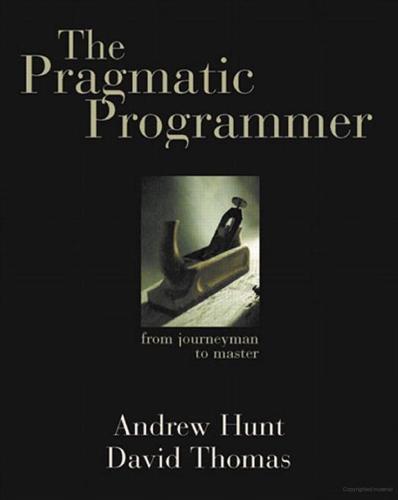
The Pragmatic Programmer
by
Andrew Hunt
and
Dave Thomas
Published 19 Oct 1999
As well as regular updates on Linux news, the site offers information on technologies that are cool and issues that affect developers. ⇒ www.slashdot.org Cetus Links. Thousands of links on object-oriented topics. ⇒ www.cetus-links.org WikiWikiWeb. The Portland Pattern Repository and patterns discussion. Not just a great resource, the WikiWikiWeb site is an interesting experiment in collective editing of ideas. ⇒ www.c2.com Internet Resources The links below are to resources available on the Internet. They were valid at the time of writing, but (the Net being what it is) they may well be out of date by the time you read this. If so, you could try a general search for the filenames, or come to the Pragmatic Programmer Web site (www.pragmaticprogrammer.com) and follow our links.

Here Comes Everybody: The Power of Organizing Without Organizations
by
Clay Shirky
Published 28 Feb 2008
CHAPTER 5: PERSONAL MOTIVATION MEETS COLLABORATIVE PRODUCTION Page 111: wikis Wikis are one of the great surprises of the last ten years’ worth of work on social tools. While many such tools were simply updates of work done in the 1960s through 1980s, wikis offered a genuinely new pattern of interaction. There are now millions of wikis in operation, both out in public and inside organizations. Ward Cunningham’s original wiki is still in operation at c2.com/cgi/wiki. The Wikimedia Foundation, nonprofit parent of Wikipedia, has a number of other wiki-based projects in operation, all listed at wikimedia.org. One of the best descriptions of the history and development of Wikipedia itself is at Marshall Poe’s excellent “The Hive,” Atlantic Monthly, September 2006, and at www.theatlantic.com/doc/200609/wikipedia. .
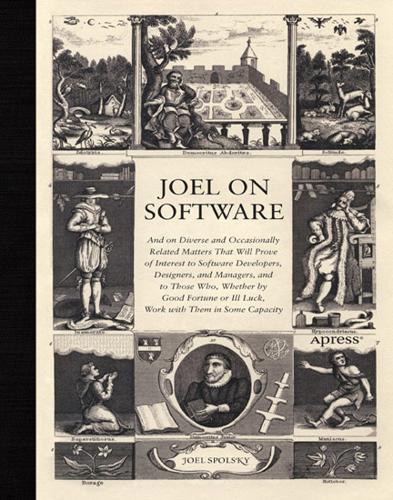
Joel on Software
by
Joel Spolsky
Published 1 Aug 2004
Raymond has convinced me that threads are usually not as good a solution as separate processes;2 indeed, years of experience have shown me that programming with multiple threads creates much additional complexity and introduces whole new categories of dangerously frightful heisenbugs.3 #3 seemed like a good solution, especially since our underlying database is multi-user and doesn't mind lots of processes banging on it at the same time. So that's what I'm planning to do when I get back from Thanksgiving vacation. __________ 2. See www.faqs.org/docs/artu/ch07s03.html#id2923889. 3. For more information on heisenbugs, see c2.com/cgi/like?HeisenBug. Notice, though, the big picture. We've gone from read the file/save it in the database to something significantly more complicated: launch a child process, tell it to read the file and save it in the database, add a progress bar and cancel button to the child process, and then some kind of mechanism so the child can notify the parent when the file has arrived so it can be displayed.

Working Effectively With Legacy Code
by
Michael Feathers
Published 14 Jul 2004
The tests will run, but they won’t pass. Later developers can add in the features, and the tests will pass. Both users and developers can have a common and up-to-date view of the capabilities of the system. There is far more to FIT than I can describe here. There is more information about FIT at http://fit.c2.com. Fitnesse Fitnesse is essentially FIT hosted in a wiki. Most of it was developed by Robert Martin and Micah Martin. I worked on a little bit of it, but I dropped out to concentrate on this book. I’m looking forward to getting back to work on it soon. Fitnesse supports hierarchical web pages that define FIT tests.
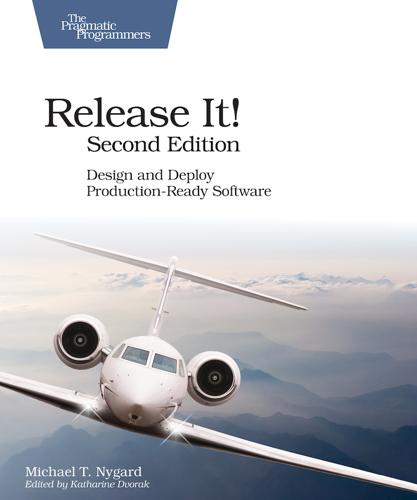
The Nature of Software Development: Keep It Simple, Make It Valuable, Build It Piece by Piece
by
Ron Jeffries
Published 14 Aug 2015
In this chapter, we’ve seen how to handle our versions to aid others and how to defend ourselves against version changes in our consumers and providers. Next we look at the operations side of the equation—namely, how to build transparency into our systems and how to adapt when transparency reveals a need for change. Footnotes [79] https://tools.ietf.org/html/rfc761#section-2.10 [80] http://fit.c2.com/ Copyright © 2018, The Pragmatic Bookshelf. Part 4 Solve Systemic Problems Chapter 15 Case Study: Trampled by Your Own Customers After years of work, the day of launch finally arrived. I had joined this huge team (more than three hundred in total) nine months earlier to help build a complete replacement for a retailer’s online store, content management, customer service, and order-processing systems.
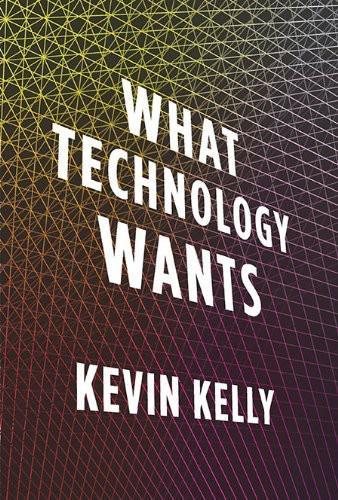
What Technology Wants
by
Kevin Kelly
Published 14 Jul 2010
MITnews. http://web.mit.edu/newsoffice/1998/wam.html. 311 on this planet are parasitic: Peter W. Price. (1977) “General Concepts on the Evolutionary Biology of Parasites.” Evolution, 31 (2). http://www.jstor.org.libaccess.sjlibrary.org/stable/2407761. 314 collaboratively write and edit material: Ward Cunningham. “Publicly Available Wiki Software Sorted by Name.” http://c2.com/cgi/wiki?WikiEngines. 314 by YouTube each month in the United States alone: comScore. (2009) “YouTube Surpasses 100 Million U.S. Viewers for the First Time.” ComScore. http://www.comscore.com/Press_Events/Press_Releases/2009/3/YouTube_Surpasses_100_Million_US_Viewers. 314 stories deposited on fan-fiction sites: M.
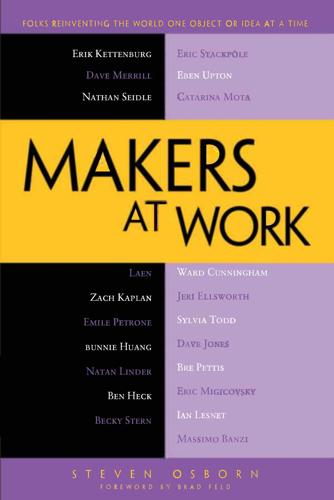
Makers at Work: Folks Reinventing the World One Object or Idea at a Time
by
Steven Osborn
Published 17 Sep 2013
Mota: It was nice talking to you. 1 Open-source 3D printers (www.reprap.org). 2 http://cyber.law.harvard.edu/wealth_of_networks/ 3 Printed circuit boards. 4 www.cmarcelo.com/pulp-based-computing 5 http://web.media.mit.edu/∼plusea 6 www.khanacademy.org 7 http://altlab.org CHAPTER 14 Ward Cunningham Inventor Wiki Ward Cunningham (http://c2.com/∼ward/) has made many contributions to software programming and the Internet. Ward laid groundwork that established design patterns1 and extreme programming2 as common practices in computer software design. His work on design patterns led to his invention of the Wiki, which has changed the way information is collected and shared around the world on the Internet.

The Future of the Internet: And How to Stop It
by
Jonathan Zittrain
Published 27 May 2009
See Fredrik Wacka, Why Blogs Rank High in Search Engines, WEB PRO NEWS, Jan. 4, 2005, http://www.webpronews.com/insiderreports/2005/01/04/why-blogs-rank-high-in-search-engines (explaining that blog entries rank high because they are filled frequently with relevant keywords, cut straight to the point, use entry titles as page titles, are coded well, and usually stick to one topic per post). 81. See Lost Camera, http://lostcamera.blogspot.com. 82. See Peter Meyers, Fact-Driven? Collegial? Then This Site Wants You, NY. TIMES, Sept. 20, 2001, at G2. 83. See Ward Cunningham, Wiki Design Principles http://www.c2.com/cgi/wikiiWiki DesignPrinciples (as of Mar. 26, 2007, 12:00 GMT) (explaining that his goals for the first release of Wiki included designing an “organic” system in which “[t]he structure and text content of the site are open to editing and evolution,” in which “[t]he mechanisms of editing and organizing are the same as those of writing so that any writer is automatically an editor and organizer,” and in which “[a]ctivity within the site can be watched and reviewed by any other visitor to the site”).

Peer-to-Peer
by
Andy Oram
Published 26 Feb 2001
Recently, there’s been a new emphasis on the “writable Web,” with projects like Dave Winer’s EditThisPage.Com (http://www.editthispage.com), Dan Bricklin’s Trellix (http://www.trellix.com), and Pyra’s Blogger (http://www.blogger.com) making it easy for anyone to host their own site and discussion area. Wiki (http://c2.com/cgi/wiki?WikiWikiWeb) is an even more extreme innovation, creating web sites that are writable by anyone in an area set aside for public comment on a given topic. Wiki has actually been around for about six or seven years, but has suddenly started to catch on. The writable Web is only one way that the Web is recapturing its peer-to-peer roots.

The Singularity Is Near: When Humans Transcend Biology
by
Ray Kurzweil
Published 14 Jul 2005
Duane Rettig wrote: "... companies rode the great AI wave in the early 80's, when large corporations poured billions of dollars into the AI hype that promised thinking machines in 10 years. When the promises turned out to be harder than originally thought, the AI wave crashed, and Lisp crashed with it because of its association with AI. We refer to it as the AI Winter." Duane Rettig quoted in "AI Winter," http://c2.com/cgi/wiki?AiWinter. 163. The General Problem Solver (GPS) computer program, written in 1957, was able to solve problems through rules that allowed the GPS to divide a problem's goals into subgoals, and then check if obtaining a particular subgoal would bring the GPS closer to solving the overall goal.

Designing Data-Intensive Applications: The Big Ideas Behind Reliable, Scalable, and Maintainable Systems
by
Martin Kleppmann
Published 17 Apr 2017
This Vulnerability,” foxglovesecurity.com, November 6, 2015. [7] Patrick McKenzie: “What the Rails Security Issue Means for Your Startup,” kalzu‐ meus.com, January 31, 2013. [8] Eishay Smith: “jvm-serializers wiki,” github.com, November 2014. 140 | Chapter 4: Encoding and Evolution [9] “XML Is a Poor Copy of S-Expressions,” c2.com wiki. [10] Matt Harris: “Snowflake: An Update and Some Very Important Information,” email to Twitter Development Talk mailing list, October 19, 2010. [11] Shudi (Sandy) Gao, C. M. Sperberg-McQueen, and Henry S. Thompson: “XML Schema 1.1,” W3C Recommendation, May 2001. [12] Francis Galiegue, Kris Zyp, and Gary Court: “JSON Schema,” IETF InternetDraft, February 2013. [13] Yakov Shafranovich: “RFC 4180: Common Format and MIME Type for Comma-Separated Values (CSV) Files,” October 2005. [14] “MessagePack Specification,” msgpack.org. [15] Mark Slee, Aditya Agarwal, and Marc Kwiatkowski: “Thrift: Scalable CrossLanguage Services Implementation,” Facebook technical report, April 2007. [16] “Protocol Buffers Developer Guide,” Google, Inc., developers.google.com. [17] Igor Anishchenko: “Thrift vs Protocol Buffers vs Avro - Biased Comparison,” slideshare.net, September 17, 2012. [18] “A Matrix of the Features Each Individual Language Library Supports,” wiki.apache.org. [19] Martin Kleppmann: “Schema Evolution in Avro, Protocol Buffers and Thrift,” martin.kleppmann.com, December 5, 2012. [20] “Apache Avro 1.7.7 Documentation,” avro.apache.org, July 2014. [21] Doug Cutting, Chad Walters, Jim Kellerman, et al.: “[PROPOSAL] New Subpro‐ ject: Avro,” email thread on hadoop-general mailing list, mail-archives.apache.org, April 2009. [22] Tony Hoare: “Null References: The Billion Dollar Mistake,” at QCon London, March 2009. [23] Aditya Auradkar and Tom Quiggle: “Introducing Espresso—LinkedIn’s Hot New Distributed Document Store,” engineering.linkedin.com, January 21, 2015. [24] Jay Kreps: “Putting Apache Kafka to Use: A Practical Guide to Building a Stream Data Platform (Part 2),” blog.confluent.io, February 25, 2015. [25] Gwen Shapira: “The Problem of Managing Schemas,” radar.oreilly.com, Novem‐ ber 4, 2014. [26] “Apache Pig 0.14.0 Documentation,” pig.apache.org, November 2014. [27] John Larmouth: ASN.1 Complete.
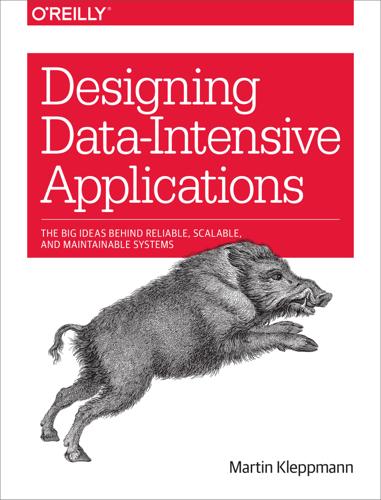
Designing Data-Intensive Applications: The Big Ideas Behind Reliable, Scalable, and Maintainable Systems
by
Martin Kleppmann
Published 16 Mar 2017
[6] Steve Breen: “What Do WebLogic, WebSphere, JBoss, Jenkins, OpenNMS, and Your Application Have in Common? This Vulnerability,” foxglovesecurity.com, November 6, 2015. [7] Patrick McKenzie: “What the Rails Security Issue Means for Your Startup,” kalzumeus.com, January 31, 2013. [8] Eishay Smith: “jvm-serializers wiki,” github.com, November 2014. [9] “XML Is a Poor Copy of S-Expressions,” c2.com wiki. [10] Matt Harris: “Snowflake: An Update and Some Very Important Information,” email to Twitter Development Talk mailing list, October 19, 2010. [11] Shudi (Sandy) Gao, C. M. Sperberg-McQueen, and Henry S. Thompson: “XML Schema 1.1,” W3C Recommendation, May 2001. [12] Francis Galiegue, Kris Zyp, and Gary Court: “JSON Schema,” IETF Internet-Draft, February 2013
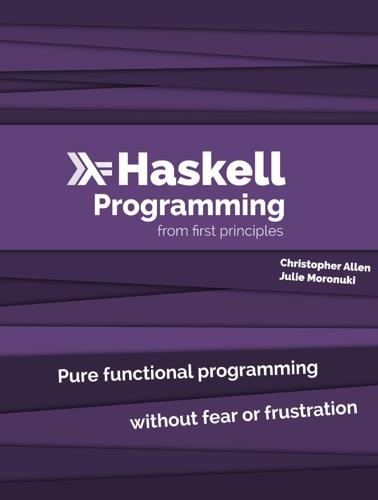
Haskell Programming: From First Principles
by
Christopher Allen
and
Julie Moronuki
Published 1 Jan 2015
A typical fizzbuzz solution in Haskell looks something like: fizzBuzz :: Integer -> String fizzBuzz n | n `mod` 15 == 0 = | n `mod` 5 == 0 = | n `mod` 3 == 0 = | otherwise = "FizzBuzz" "Fizz" "Buzz" show n main :: IO () main = mapM_ (putStrLn . fizzBuzz) [1..100] You will craft a fizzbuzz that makes gouts of blood come out of your interviewer’s eye sockets using State. This is a suitable punishment for asking a software candidate to write this in person after presumably getting through a couple phone screens. 4 http://c2.com/cgi/wiki?FizzBuzzTest CHAPTER 23. STATE 835 import Control.Monad import Control.Monad.Trans.State fizzBuzz :: Integer -> String fizzBuzz n | n `mod` 15 == 0 = | n `mod` 5 == 0 = | n `mod` 3 == 0 = | otherwise = "FizzBuzz" "Fizz" "Buzz" show n fizzbuzzList :: [Integer] -> [String] fizzbuzzList list = execState (mapM_ addResult list) [] addResult :: Integer -> State [String] () addResult n = do xs <- get let result = fizzBuzz n put (result : xs) main :: IO () main = mapM_ putStrLn $ reverse $ fizzbuzzList [1..100] The good part here is that we’re collecting data initially before dumping the results to standard output via putStrLn.